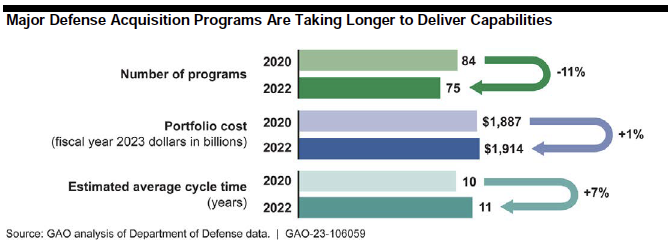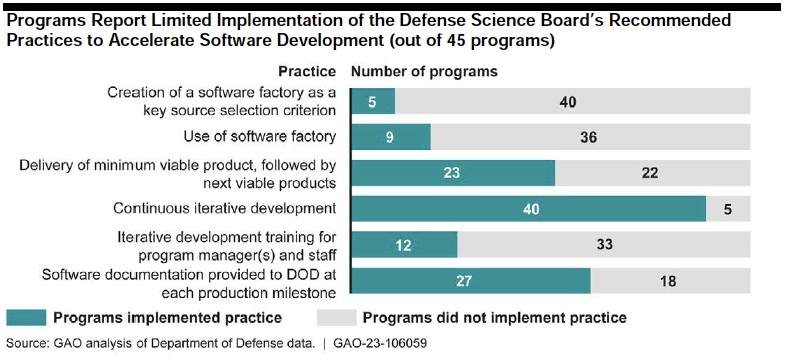The following is the June 8, 2023, Government Accountability Office annual 2023 Weapon Systems Annual Assessment.
From the report
What GAO Found
The Department of Defense (DOD) continues to face challenges quickly developing innovative new weapons. These challenges persist even with recent reforms to its acquisition process intended to help deliver systems to the warfighter in a timelier manner.
Major defense acquisition programs. From DOD’s 2020 submission of reports on their major defense acquisition programs to 2022, the number of these programs declined. However, the portfolio’s total cost increased, and the average planned cycle time to deliver operational capabilities shows new delays. DOD did not produce these reports in 2021 due to the lack of future year funding data in the fiscal year 2022 budget request.
Over half of the 26 major defense acquisition programs GAO assessed that had yet to deliver operational capability reported new delays. Driving factors included supplier disruptions, software development delays, and quality control deficiencies. Additionally, these programs continue to make investment decisions without sufficient knowledge, which can increase the risk of delays. Net costs for the 32 major defense acquisition programs that GAO assessed both this year and last year increased by $37 billion. Rising modernization costs, production inefficiencies, and supply chain challenges drove the majority of costs.
Middle tier of acquisition (MTA) programs. Two MTA efforts transitioned to become major defense acquisition programs since GAO’s last assessment and could begin delivering capabilities soon. However, other MTA efforts’ schedule delays and lack of progress in maturing technologies raise questions about MTA programs’ overall ability to deliver capabilities more quickly.
Of the 16 rapid prototyping efforts included in both GAO’s current and prior assessments, six have delayed planned operational demonstrations by at least 12 months. The later that demonstrations occur during the MTA effort, the less time programs will have to address emerging issues. This delay heightens the chance that programs will transition with more technical risk.
Software development approaches and cybersecurity practices. Programs reporting use of modern software development approaches increased over the past year from 43 of 59 programs (73 percent) to 45 of 58 programs (78 percent). But, programs reported limited implementation of the Defense Science Board’s recommended practices to accelerate software development.
GAO also observed mixed progress in cybersecurity planning. All programs had or planned to have a cybersecurity strategy. But, programs did not consistently report scheduling cybersecurity test events in time to inform key milestones. Without timely cybersecurity testing, programs are at greater risk of delays if issues are discovered later in development.
Key product development principles. GAO found that some—but not all—MTA and future programs used certain product development practices aligned with key product development principles employed by leading companies to deliver innovative capabilities quickly. Examples reported by programs included practices such as using 3D modeling and printing to help design and test products, and holding regular user testing events to obtain feedback. GAO has ongoing work to define associated metrics to help inform future assessments.
Modular open systems approach. Most programs GAO reviewed reported using a modular open systems approach. But they did not consistently report planning to verify successful implementation of the approach before key points in the acquisition process, such as before beginning production. A modular open systems approach enables weapon programs to better respond to changing threats, in part, by allowing them to more easily add, remove, and replace components over the system’s life cycle.
Neither DOD systems engineering policy nor modular open systems approach guidance specifically addresses when programs should complete or document verification testing. Ensuring that any new guidance and updates to relevant policies address when programs should conduct verification testing and document planning could help DOD ensure its systems can incorporate innovative technologies over time to remain responsive to emerging threats.
Download the document here.








